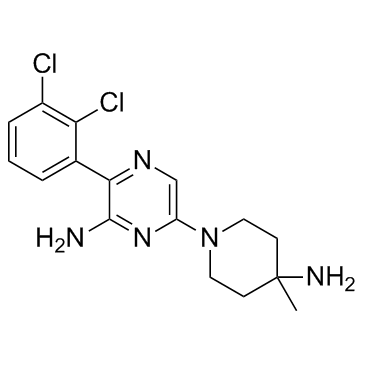1801747-42-1
| Name | 6-(4-Amino-4-methyl-1-piperidinyl)-3-(2,3-dichlorophenyl)-2-pyrazinamine |
|---|---|
| Synonyms |
6-(4-Amino-4-methyl-1-piperidinyl)-3-(2,3-dichlorophenyl)-2-pyrazinamine
2-Pyrazinamine, 6-(4-amino-4-methyl-1-piperidinyl)-3-(2,3-dichlorophenyl)- SHP099 free base SHP099 |
| Description | SHP099 is a potent, selective, orally available SHP2 inhibitor with an IC50 of 70 nM. |
|---|---|
| Related Catalog | |
| Target |
IC50: 70 nM (SHP2)[1] |
| In Vitro | The X-ray co-crystal for SHP099 with SHP2 reveals a new interaction with the basic amine and the Phe113 backbone carbonyl. SHP099 shows inhibition of cell proliferation (KYSE-520 model) with an IC50 of 1.4 μM. SHP099 shows high solubility and high permeability with no apparent efflux in Caco-2 cells[1]. SHP099 concurrently binds to the interface of the N-terminal SH2, C-terminal SH2, and protein tyrosine phosphatase domains, thus inhibiting SHP2 activity through an allosteric mechanism. SHP099 suppresses RAS–ERK signalling to inhibit the proliferation of receptor-tyrosine-kinase-driven human cancer cells[2]. |
| In Vivo | After a single doses of 30 and 100 mg/kg (red and blue lines, respectively), dose-dependent exposure and modulation of the pharmacodynamic marker p-ERK is observed in the xenografts. A daily oral dose of 10 or 30 mg/kg yield 19% and 61% tumor growth inhibition, respectively. Tumor stasis is achieved at 100 mg/kg[1]. |
| Kinase Assay | The inhibition of SHP2 from the tested compounds (SHP099) concentrations varying from 0.003-100 μM is monitored using an assay in which 0.5 nM of SHP2 is incubated with of 0.5 μM of peptide IRS1_pY1172(dPEG8)pY1222. After 30-60 minutes incubation at the surrogate substrate, DiFMUP is added to the reaction and incubated at 25 °C for 30 minutes. The reaction is then quenched by the addition of 5 μL of a 160 μM solution of bpV(Phen). The fluorescence signal is monitored using a microplate reader using excitation and emission wavelengths of 340 nm and 450 nm, respectively[1]. |
| Cell Assay | Cells are plated onto 96-well plates in 100 μL medium. SHP099 with various concentrations (1.25, 2.5, 5, 10, 20 μM) are added 24 h after cell plating. At day 5, 50 μL Celltiter-Glo reagent is added, and the luminescent signal is determined[1]. |
| References |
| Density | 1.3±0.1 g/cm3 |
|---|---|
| Boiling Point | 530.4±50.0 °C at 760 mmHg |
| Molecular Formula | C16H19Cl2N5 |
| Molecular Weight | 352.262 |
| Flash Point | 274.5±30.1 °C |
| Exact Mass | 351.101746 |
| LogP | 3.97 |
| Vapour Pressure | 0.0±1.4 mmHg at 25°C |
| Index of Refraction | 1.626 |
| Storage condition | -20℃ |
